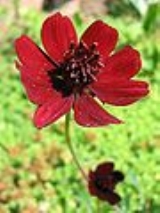
Cosmos atrosanguineus
Encyclopedia
Cosmos atrosanguineus (Chocolate Cosmos) is a species of Cosmos, native to Mexico
, where it is extinct
in the wild. The species was introduced into cultivation in 1902, where it survives as a single clone
reproduced by vegetative propagation
.
It is a herbaceous
perennial plant
growing to 40-60 cm tall, with a fleshy tuber
ous root. The leaves
are 7-15 cm long, pinnate, with leaflets 2-5 cm long. The flower
s are produced in a capitulum
3-4.5 cm diameter, dark red to maroon-dark brown, with a ring of six to ten (usually eight) broad ray florets and a center of disc florets; they have a light vanillin
fragrance (like many chocolate
s), which becomes more noticeable as the summer day wears on. http://www.sfgate.com/cgi-bin/article.cgi?f=/c/a/2009/02/21/HOFK15MMOG.DTL&type=homeandgarden
, grown for its rich dark red-brown flowers. It is not self-fertile, so no viable seed
s are produced, and the plant has to be propagated by division of the tubers.
It requires partial sun or full sun, and flowers from mid to late summer. It is frost-sensitive (Zones 6-11); in temperate zones, the tuber has to be dug up and stored in a frost-free store over the winter.
Mexico
The United Mexican States , commonly known as Mexico , is a federal constitutional republic in North America. It is bordered on the north by the United States; on the south and west by the Pacific Ocean; on the southeast by Guatemala, Belize, and the Caribbean Sea; and on the east by the Gulf of...
, where it is extinct
Extinct species
This page features extinct species, organisms that have become extinct.* List of extinct animals* List of extinct plants...
in the wild. The species was introduced into cultivation in 1902, where it survives as a single clone
Cloning
Cloning in biology is the process of producing similar populations of genetically identical individuals that occurs in nature when organisms such as bacteria, insects or plants reproduce asexually. Cloning in biotechnology refers to processes used to create copies of DNA fragments , cells , or...
reproduced by vegetative propagation
Vegetative reproduction
Vegetative reproduction is a form of asexual reproduction in plants. It is a process by which new individuals arise without production of seeds or spores...
.
It is a herbaceous
Herbaceous
A herbaceous plant is a plant that has leaves and stems that die down at the end of the growing season to the soil level. They have no persistent woody stem above ground...
perennial plant
Perennial plant
A perennial plant or simply perennial is a plant that lives for more than two years. The term is often used to differentiate a plant from shorter lived annuals and biennials. The term is sometimes misused by commercial gardeners or horticulturalists to describe only herbaceous perennials...
growing to 40-60 cm tall, with a fleshy tuber
Tuber
Tubers are various types of modified plant structures that are enlarged to store nutrients. They are used by plants to survive the winter or dry months and provide energy and nutrients for regrowth during the next growing season and they are a means of asexual reproduction...
ous root. The leaves
Leaf
A leaf is an organ of a vascular plant, as defined in botanical terms, and in particular in plant morphology. Foliage is a mass noun that refers to leaves as a feature of plants....
are 7-15 cm long, pinnate, with leaflets 2-5 cm long. The flower
Flower
A flower, sometimes known as a bloom or blossom, is the reproductive structure found in flowering plants . The biological function of a flower is to effect reproduction, usually by providing a mechanism for the union of sperm with eggs...
s are produced in a capitulum
Inflorescence
An inflorescence is a group or cluster of flowers arranged on a stem that is composed of a main branch or a complicated arrangement of branches. Strictly, it is the part of the shoot of seed plants where flowers are formed and which is accordingly modified...
3-4.5 cm diameter, dark red to maroon-dark brown, with a ring of six to ten (usually eight) broad ray florets and a center of disc florets; they have a light vanillin
Vanillin
Vanillin is a phenolic aldehyde, an organic compound with the molecular formula C8H8O3. Its functional groups include aldehyde, ether, and phenol. It is the primary component of the extract of the vanilla bean. It is also found in Leptotes bicolor, roasted coffee and the Chinese red pine...
fragrance (like many chocolate
Chocolate
Chocolate is a raw or processed food produced from the seed of the tropical Theobroma cacao tree. Cacao has been cultivated for at least three millennia in Mexico, Central and South America. Its earliest documented use is around 1100 BC...
s), which becomes more noticeable as the summer day wears on. http://www.sfgate.com/cgi-bin/article.cgi?f=/c/a/2009/02/21/HOFK15MMOG.DTL&type=homeandgarden
Cultivation and uses
The single surviving clone is a popular ornamental plantOrnamental plant
Ornamental plants are plants that are grown for decorative purposes in gardens and landscape design projects, as house plants, for cut flowers and specimen display...
, grown for its rich dark red-brown flowers. It is not self-fertile, so no viable seed
Seed
A seed is a small embryonic plant enclosed in a covering called the seed coat, usually with some stored food. It is the product of the ripened ovule of gymnosperm and angiosperm plants which occurs after fertilization and some growth within the mother plant...
s are produced, and the plant has to be propagated by division of the tubers.
It requires partial sun or full sun, and flowers from mid to late summer. It is frost-sensitive (Zones 6-11); in temperate zones, the tuber has to be dug up and stored in a frost-free store over the winter.

